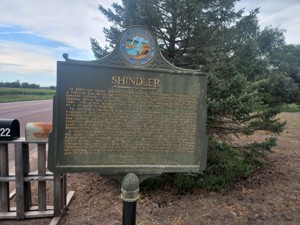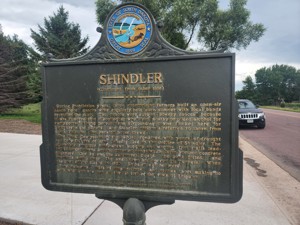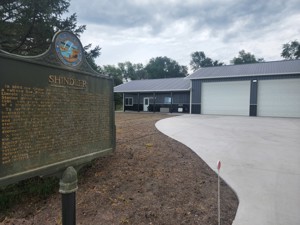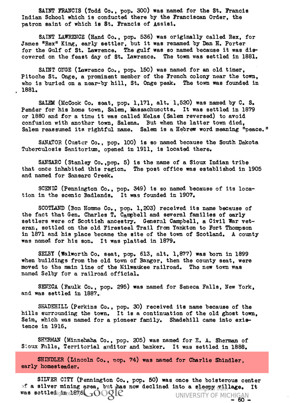“Shindler”

(Note: any text in italics has been taken from the official SDSHS records.)
Subject
A place. The former town of Shindler which has been gone since 1953.
Marker Text
In 1886 the Cedar Rapids, Iowa Falls & Northwestern Railroad built a railway line form Larchwood, Iowa, through Springdale Township, Lincoln County, to Sioux Falls, Dakota Territory. The Springdale Station depot was established here; later it became Hobsonville. In 1891, two years after statehood, it was renamed Shindler in memory of a pioneer homesteader.
To serve the needs of area farmers, tradesmen built stores for their businesses and homes for their families on this site. Businesses included the Shindler State Bank, a general store, hardware store and lumber yard, post office, blacksmith shop, garage and service station, grain elevator, stockyards for shipping of livestock by train, and a barber. The Chicago, Rock Island and Pacific Line, the successor railroad, provided daily passenger, freight, and mail services.
A town hall opened in 1910 and quickly became the social hub for the small community. The hall hosted square dances, church services, Sunday school, basketball games, school programs, Red Cross meetings, talent plays, and community parties. An annual diversion for area residents was provided when the circus train rolled through town. Parents and their excited children gathered at the depot and alongside the railroad tracks to wave at the railroad cars carrying wild animals and entertainers.
During Prohibition years, three enterprising farmers built an open-air dance floor; dances were regularly held each summer with local bands providing the music. The dances were dubbed ‘Bowery dances’ because it was rumored that a bootlegger who lived nearby provided alcohol for partygoers. Young people from surrounding towns flocked here for Saturday night dances, and Shindler residents referred to those from Sioux Falls as ‘the packing house crowd.'
The Great Depression of the 1930s, combined with years of drought and crop failures of area farmers, led to the decline of Shindler. The automobile replaced horse-drawn buggies and wagons. Dirt trails leading to larger towns became graveled roads which later became concrete highways. One by one the businesses closed, the bank failed, and residents moved away. The small town had served its purpose. When the post office closed in 1953, Shindler was no more. Fond memories, tales of simpler times, and stories about making do with what one has are all that is left of the town of Shindler.
Dedication Note
Dedicated in 2003 by former residents and friends of Shindler
Dedicated in 2003 by the South Dakota State Historical Society, and the South Dakota Department of Transportation
Location
Lincoln County, SD Highway 11 by Shindler City Road Sign (2006)
From Sioux Falls, take 57th Street east to Highway 11. Turn right (south), towards Frankman Automotive. The marker is about two miles down on the left side of the road. There is a wide shoulder for parking.
As of August 2022, the marker was right next to the driveway of a new commercial building.
There used to be a black-and-white wooden railroad sign next to the market (presumably the original?), but it’s since been removed.
Is there anything to see?
No. The marker is by the side of the road within a modern development of buildings on Highway 11. I drove around the area quite a bit, and I didn’t find anything that could be considered remnants of the town.
Marker Images


Other Images




Links to Additional Information
Wikipedia claims Shindler still exists:
Shindler is an unincorporated community and census-designated place (CDP) in Lincoln County, South Dakota, United States. The population was 607 at the 2020 census.[2]
Their coordinates put it further north, just south of Frankman Automotive.
This is what the census bureau says about Census Designated Places (CDP):
The purpose of CDPs is to provide meaningful statistics for well-known, unincorporated communities.
Here’s the profile for Shindler in the census records. They give it boundaries, and have it extending quite a bit east of Highway 11.
I drove around the CDP area, and there’s an extensive housing community back there. I’m curious if these residents identify with “Shindler” as the place they live? I assume they’re technically just in unincorporated Lincoln County.
Every day, between 7,000 and 10,000 unique visitors come to this website. I don't keep analytics, so I have no idea why you're here. Maybe get in touch with me and tell me why you visited today?